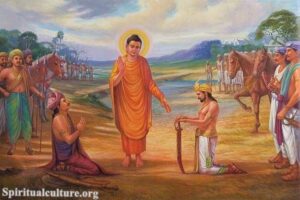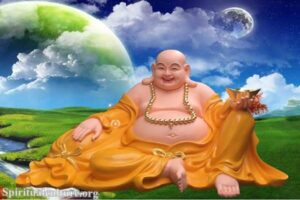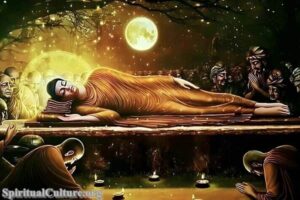In this age of constant connection, swiping, scrolling, and streaming, we are more digitally linked than ever before—yet, strangely, we often feel more alone, anxious, and untethered. The speed of technology races ahead, but the soul lags behind, searching for something still, something eternal.
As Spiritual Culture, we invite you to pause in this moment—to explore why the Buddha’s teachings, born in the forests of ancient India over 2,500 years ago, remain not only relevant but urgently needed in today’s digital reality. This is not merely a reflection on ancient wisdom but a call to reawaken the timeless truths within ourselves, amid the noise of modern life.
This article explores the intersection of Buddhist wisdom and the digital age, revealing how mindfulness, ethical living, and inner freedom offer powerful tools to navigate our overstimulated world with grace and grounded presence.
The Buddha’s Timeless Insight into Suffering
The Universal Problem: Dukkha
At the heart of the Buddha’s teachings lies the concept of dukkha—often translated as suffering, dissatisfaction, or stress. Long before smartphones and social media, the Buddha taught that life, by its very nature, contains moments of discomfort, longing, and impermanence.
Digital Dukkha: New Forms, Same Pattern
Today, dukkha wears digital clothes. It appears in the form of:
- Comparison on social media: “Why is everyone happier than me?”
- Digital addiction: compulsive checking, endless scrolling
- Fear of missing out (FOMO): anxiety from always being online
- Mental fragmentation: difficulty staying present and focused
Though our tools have changed, the core human struggle has not. The Buddha saw deeply into this timeless pattern—and offered a path to freedom.
“I teach one thing and one thing only: suffering and the end of suffering.” — The Buddha
The Digital Mind and the Need for Mindfulness
The Scattered Mind in the Information Age
In the digital age, our attention is the most valuable—and most exploited—resource. With every notification, our awareness is hijacked. We are trained to multitask, to react instantly, and to fear silence.
Buddhism, in contrast, teaches us to cultivate the single-pointed mind—to return, again and again, to this breath, this step, this moment.
Mindfulness: A Radical Return to Now
The Pali word sati, often translated as mindfulness, means remembering to be present. In a world that constantly pulls us away from ourselves, mindfulness is an act of spiritual resistance.
“Do not dwell in the past, do not dream of the future, concentrate the mind on the present moment.” — The Buddha
Apps can track our screen time, but only mindfulness can restore our soul’s time.
Ethical Living in a Virtual World
The Five Precepts in Digital Context
The Buddha gave simple ethical guidelines to help us live in harmony:
- Do not kill
- Do not steal
- Do not lie
- Do not engage in sexual misconduct
- Do not consume intoxicants
Digital Extensions of the Precepts
In the digital world, these precepts take on new meaning:
- Do not kill compassion: Avoid online cruelty, trolling, or dehumanizing others.
- Do not steal attention: Refrain from manipulative clickbait or deceitful content.
- Do not lie: Share truthfully, even when exaggeration is tempting.
- Respect boundaries: Practice consent and dignity in all digital interactions.
- Remain lucid: Don’t let digital intoxication cloud judgment or inner peace.
Buddhist ethics are not a list of rules—they are a mirror to examine how we live, even behind screens.
Interdependence in a Globalized, Connected World
The Illusion of Separation
The Buddha taught pratītyasamutpāda—dependent origination: that all things arise in dependence upon conditions. Nothing exists in isolation. Every action ripples outward.
The Internet as a Metaphor for Interbeing
What could illustrate interdependence better than the internet itself?
- A tweet in one country sparks protests in another
- A livestream touches hearts across the globe
- A moment of kindness goes viral
This vast web mirrors what Thich Nhat Hanh called interbeing—the truth that “we are because everything else is.” The digital world can remind us of this sacred entanglement, or obscure it, depending on how we engage.
“As a net is made up of a series of ties, so everything in this world is connected by a series of ties.” — The Buddha
Emptiness and the Ego Online
The Digital Self: Carefully Curated Illusion
In the age of profiles and selfies, we are constantly projecting versions of ourselves—highlight reels, avatars, filters, brands.
But Buddhism teaches that the self is anatta—not a fixed entity but a flow of changing experiences, conditioned thoughts, and momentary formations.
Freedom from Online Identity Traps
When we cling to digital identities, we suffer. We:
- Feel pressure to perform
- Fear being “canceled” or unseen
- Attach to likes as measures of worth
The teaching of emptiness (śūnyatā) offers liberation: you are not your username. You are not your follower count. You are vast, dynamic, ungraspable—like the sky.
Silence as Sacred: Reclaiming the Pause
Noble Silence in a Noisy Age
The Buddha often responded to the deepest questions not with elaborate theories, but with noble silence—a silence that pointed beyond words to a deeper knowing.
Today, silence is rare. We fear it. We fill it. Yet silence is where truth grows.
Practicing digital restraint—turning off notifications, setting aside the phone, observing moments of quiet—becomes a modern form of monastic practice.
“When words are both true and kind, they can change the world.” — The Buddha
But silence, too, can heal what noise cannot touch.
Buddhist Technology? Ancient Wisdom Meets Modern Tools
Can the Dharma Go Digital?
Yes—and no.
- Meditation apps bring mindfulness to millions.
- Online sanghas (communities) offer global support.
- Digital Dharma talks transmit teachings across time zones.
Yet the heart of Buddhism is direct experience, not just content consumption. Watching 100 videos about mindfulness is not mindfulness.
Wisdom Beyond the Algorithm
The Buddha’s wisdom cannot be reduced to a trending topic or monetized self-help product. It demands engagement, contemplation, and practice.
Spiritual Culture encourages the integration of technology without spiritual dilution. Let the screen be a doorway, not a wall.
The Four Noble Truths in a Digital Frame
Let us revisit the Buddha’s foundational teaching through the lens of modern life:
- There is suffering
→ Digital burnout, social comparison, mental fatigue - There is a cause of suffering
→ Craving for validation, constant stimulation, egoic identity - There is an end to suffering
→ Through awareness, ethical living, and detachment - There is a path
→ The Noble Eightfold Path: Right View, Right Intention, Right Speech, Right Action, Right Livelihood, Right Effort, Right Mindfulness, Right Concentration
This path is not outdated—it is a compass for navigating the chaos of today with clarity, compassion, and calm.
What This Means for You
Reflect and Reimagine
The digital age offers us incredible tools—and immense challenges. We can either be mastered by our devices or master the inner technology of awareness.
The Buddha’s teachings do not ask you to reject technology, but to use it with wisdom, compassion, and mindfulness. To reclaim your inner stillness in a world of constant motion.
Let us close with this invitation from the Dhammapada:
“All that we are is the result of what we have thought. The mind is everything. What we think, we become.”
In this time of algorithms and avatars, your mind is still the most powerful platform. And your awakening is still the most profound revolution.
May you scroll less, breathe more, and walk this path—timeless and true.
—
Spiritual Culture
A soul-friend in the age of noise. Whispering truth into the digital wind.



